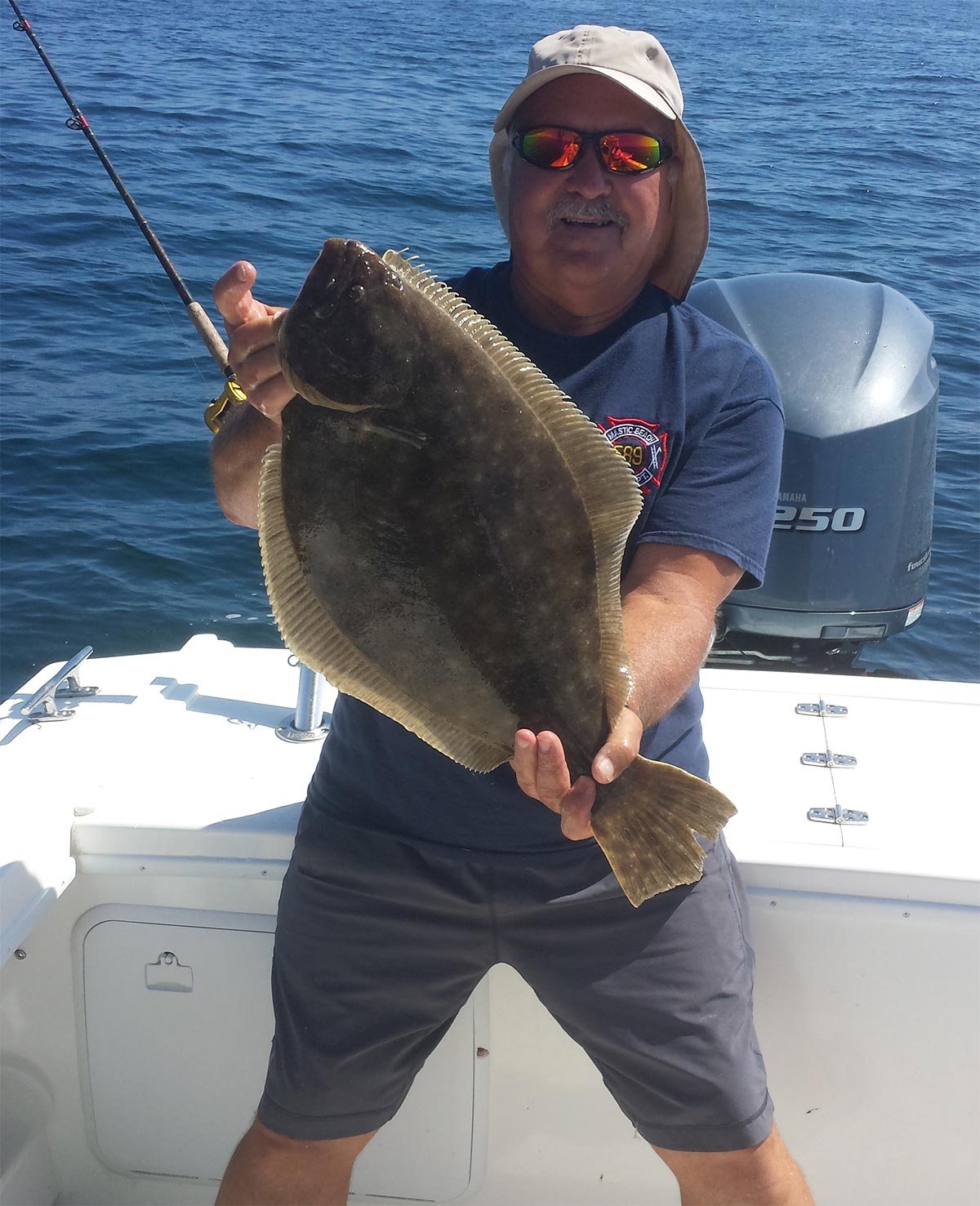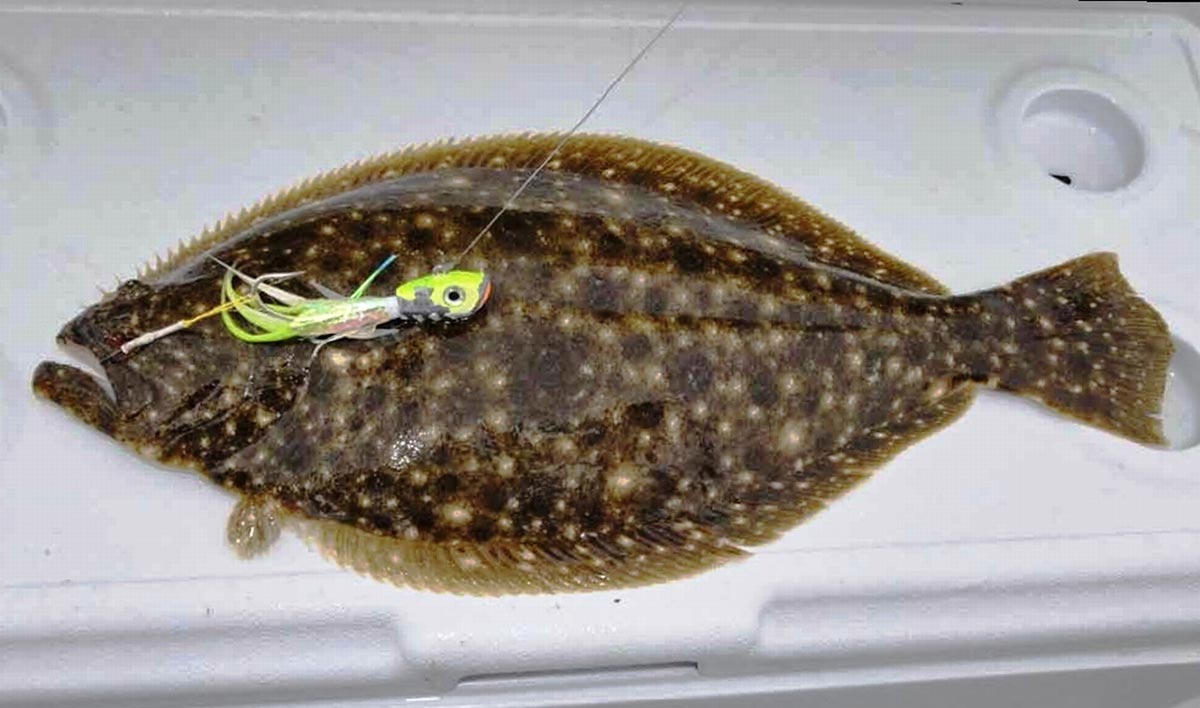With reduced commercial pressure this past spring due to the effects of COVID-19 on the market, there should be a lot of big fluke lurking in East End waters this summer.
As we settle into July, so do hefty ocean fluke situate themselves in the 60- to 100-foot depths along the Island’s East End, especially south of Montauk and eastward beyond Block Island. These trophy size flatties spend their lives in the Big Pond, wintering in the warm Gulf Stream waters of the Continental Shelf, and rarely if ever visiting the shallow South Shore bays or the harbors of Long Island Sound. These ocean fluke usually peak in July and August before starting their offshore migration around mid-September. In the meantime, areas such as Frisbees and the Cartwright Grounds, as well as Rocky Hill, the Windmills and the North Grounds are just a few of the many productive areas that are targeted by boats sailing from Orient and Montauk, as well as eastern Connecticut and Rhode Island. If slamming a few summer flounder in the 24- to 32-inch range is on your agenda, these are the areas you want to target.
Speedy boats and the simplicity of navigational electronics have made day trips possible for anglers who trailer their boats to the ramps at Greenport, Orient and Montauk. Many sharpies rent boat slips at one of the many marinas each season just to hunt for monster flatties. Unfortunately, many of us do not have the luxury of trailering or owning a boat in the area, which leaves us with three choices: hope that a friend invites you; get some friends and family together and book one of the many charter boats in Montauk or Orient; jump on one of the several full day open boats for some easy on-easy off fishing, which only requires your pocketbook, skill and dexterity. Should you choose to leave it to the captain and crew of a charter or head boat, rest assured that these skippers will give you 110 percent in your hunt for a doormat.
Doing It on Your Own

If you are fortunate to have a vessel at least 21 feet in length that you trailer, then first and foremost; watch the weather. Pick your days wisely since the last thing you want to deal with is rough seas 8 to 10 miles offshore. Therefore plan your trips when the forecast is for light winds and sea conditions no more than 2 to 3 feet. Keep in mind that during those hot and humid summer days, most afternoons see a stiff southwest breeze whip up, which can make for a bit of a bumpy but generally safe ride. Now with that out of the way, some truly productive areas include the Frisbee Ground (N41.00.86 / W71.52.34) which is an area of rocky terrain with water depths ranging from 60 to75 feet. The name is derived from the high area that rises to 55 feet at the center of this location. Both inner and outer Frisbees are jumbo fluke and sea bass magnets. Your best bet is to fish the area dotted with lobster trap markers that sit on the rocky perimeters. Fluke activity begins here by early July and continues right through September. Should the picking be slow, you can move a little further south and work the rocky floor of the Cartwright Grounds (N40.58.580 / W71.47.03944) located six miles south of Montauk Point. The Cartwright Grounds are a 7-mile radius of rocky bottom resting in 80 to 100 feet of water. This area gets a lot of play from the Montauk party and charter boat fleet during the summer fluke run, and is known for its quantity and quality.
Fluke fishing in areas such as Frisbees and Cartwright is in a category all to itself, and it’s important to understand the layout of the bottom structure. While navigation charts and electronic devices will certainly assist in getting to the charted area, they will not tell you how they are structured. Putting in some time learning these areas will go a long way toward putting a few slabs in the box. Basic 101 just will not cut it here. Drifting directly over a high piece of big boulders or stones often results in hang ups and lost terminal tackle. Instead, drifting along the sandy fringes and in the nooks and crannies between the big boulders and rock piles are where 75 percent of the fluke will ambush their meals. Being close to a piece of structure is relevant, being on top is not. I find that fluke tend to wander within a 1/4 mile radius of the rocks at times, especially when baitfish are close by. If the recorder is marking bait, do not dismiss drifting along the sandy fringes outside a patch of rocks. In fact find the bait and you will find the fluke. It is that simple. Therefore, a quality depth recorder is paramount during your search for a big slab. Monitor the screen closely while keeping an eye out for bait on or near the bottom. Should you mark an area with a considerable amount of bait, mark the GPS coordinates, then set up a drift pattern to put you over the markings.
Not So Fast
When drifting in deep water, a drift of 1 to 1-1/2 knots is ideal since this speed will keep the fluke aggressively chasing down the bait, and minimize interference from undesirables such as skates and crabs. A drift slower than a half knot often results in a burdensome pick of skates, which can make for a frustrating time. Should that be the case, try power drifting by kicking the engine in and out of gear and keeping the boat moving at about a knot and a half. On the other hand, when the drift is much over 2 knots, it may be too fast for the depth of water that will certainly require heavy lead to hold bottom, resulting in short strikes. All is not lost however, as a sea anchor is the solution to slow the speed of the drift, and allow the bait to remain on the bottom, giving big and lazy fluke a shot at your hook. A sea-anchor is a triangular type bag attached to a length of anchor rope and placed overboard where it fills with water. It acts as a drogue and does a good job of slowing your drift. To determine what size sea anchor you should use depends on the size of the boat. Quite often when the fish are in water depths of 60 feet or better and a fast drift requires 12 or 16 ounces to touch bottom, a sea anchor can reduce the amount of lead to 4 to 6 ounces. This allows for a better feel of subtle bites, and a more spirited battle with the fish.
Gearing Up
Rods with fast taper tips for sensitivity and powerful butt tapers for the lift needed to haul any outsize flattie from the land of the giants are the way to go. Seven-foot rods and 3/0 size conventional reels in the in the 30-pound class will get the job done. The reel should start with 30-pound monofilament as backing, topped off with at least 150 yards of 30-pound braid, and finished with an 8- to 10-foot length of 30-pound mono or fluorocarbon shock leader. Whether you use a plain Jane or a bucktail rig, the combo should be sensitive to the bounce of a jig and the lightest tap from a crafty fluke.
Regular Plain Jane rigs are always reliable; in fact, they do a fabulous job nailing big fluke. Bait them up with natural bait or better yet, a nice big 6-inch Gulp Alive Swimming Mullet in white, glow, nuclear chicken or pink. Quite frankly, I am convinced that fluke go after the scent of the Gulp with color being a close second. While Plain Janes are a safe bet, the rig I favor is no secret and is known as a Christmas Tree Rig or a Chicken Rig whichever you prefer to call them. The rig consist of a pair of 1/4- or 3/8-ounce Spro Prime Bucktails tied 18 inches from each other and a 4- to 6-ounce Spro bucktail as the trailer about a foot from the lower small jig. Bait the large bucktail with a 6-inch Swimming Mullet and the two smaller bucktails each get a 3-inch Swimming Mullet. Those big fluke would rather feast on the small bucktails than the trailer about 80 percent of the time. If you prefer, instead of a large bucktail, Tsunami fluke balls are an ideal substitute and will nail their share of jumbos. If conditions permit, a lighter weight trailer bounced along the bottom will give you greater sensitivity of the rod and a better feel for those subtle bites that often come from big fluke.

Feed Them Meat
Contrary to popular belief, you do not need big baits to land big fluke. Please do not be misled, the big baits work very well on a Plain Jane, they’re just too awkward on the Christmas tree rig. Four-inch strips of squid, fluke belly or better yet, freshly stripped-down sea robin belly work great on the small bucktails, while a 7- or 8-inch strip of fresh sea robin or fluke belly is hard to beat on the bottom jig. If available, you can add fresh bluefish strips to the menu as well. Peruvian spearing and large sand eels are fine; however, if possible, use the freshest strip baits that are available, as these fish much prefer fresh red meat.
How many times have you drifted along with your mind wandering somewhere else when suddenly the tip of the rod goes into frantic mode, you swing back only to miss? Sound familiar? If it makes you feel any better, more than likely that hit of a lifetime was probably a small fish or most likely a short. The heartbreakers are the ever-so-soft taps. Small fluke are extremely aggressive and strike like lightning, whereas the fluke with shoulders are much more cautious and harder to convince to take the offering. The key to nailing these bruisers is patience, especially when long strips or live bait are employed. In other words never take the bait away from a fluke if you miss it on the first bite. The biggest mistake many anglers make is taking major league swings, and then reeling up to see if any bait remains. This is a no-no. Instead, keep the bait down there for at least a minute or two. Big fluke will follow a bait a long time before committing to it. Therefore give them a chance.
With reduced commercial pressure this past spring due to the effects of COVID-19 on the market, there should be a lot of big fluke lurking in the deep water this summer. Therefore if you are looking for some real slabs, there is no better time than in the next couple of months to bring a real trophy to the net.




